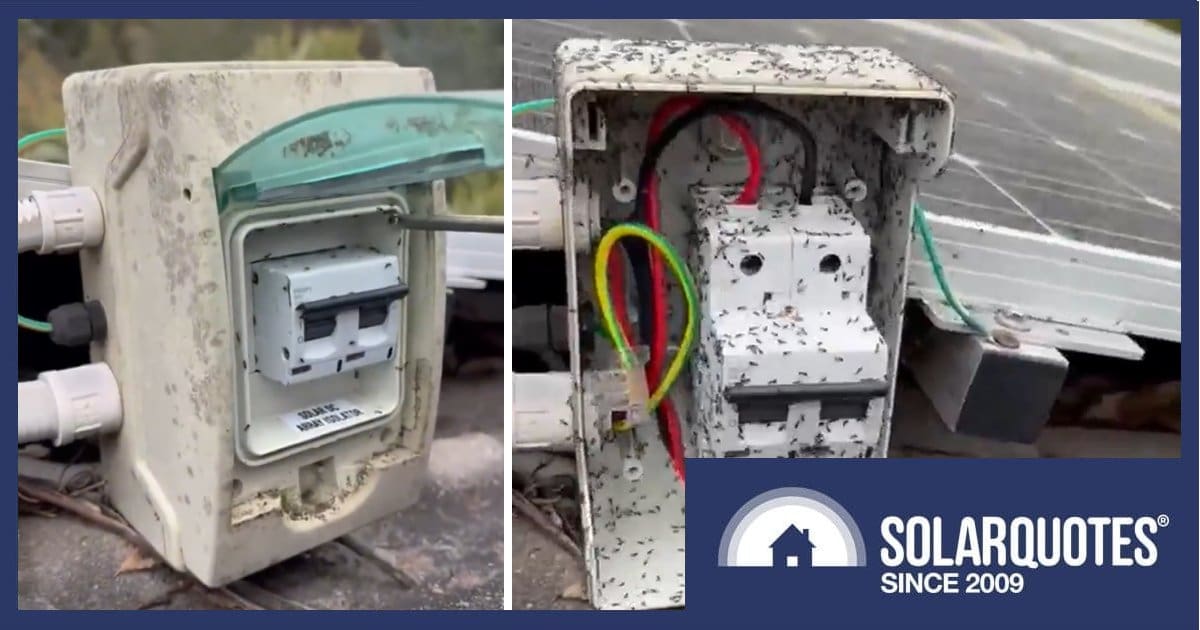
Various critters can potentially make a home among or inside the components of your solar power system, including ants. It’s another reason why visual checks where possible and regular professional solar system inspections are so important.
How Can Tiny Ants Cause Big Solar Problems?
Ants can cause issues in electrical circuits through triggering short circuits (electrocution and fire risk) and safety switches, and damaging wiring.
The Solar Repair Man carries out solar repairs and maintenance in Melbourne. During an inspection in Balwyn North, a rooftop DC isolation switch was found to be packed with ants (pictured above).
Commenting on the find, The Solar Repairman said:
“We love sharing what we find out on the job because this is the real side of solar servicing; the stuff you don’t see until someone actually opens it up. Ants, water, heat, corrosion, we come across it all.
And it’s a good reminder why regular solar inspections are so important, not just to keep things running smoothly, but to prevent safety issues before they happen.”
How the ants came to establish their penthouse digs in the DC isolator isn’t clear. While it doesn’t appear to be a commonly reported problem, ants shouldn’t be able to get into a rooftop DC isolator as it is supposed to be a safety device1 that needs to be sealed to prevent electrical shorts and system failures; more often through water ingress than ants.
Ants getting in points to a poor quality or poorly installed/maintained isolator, as it suggests the casing may not have been properly or was no longer properly sealed. Given the state of the external isolator casing, it may not have had a recommended shroud over it to help protect it from the elements. Or perhaps the ants travelled down through the conduit and wiring leading into the isolator through a point that wasn’t properly sealed.
Some ants are so small, they can get into just about anything and it’s thought some species of ants are attracted to magnetic fields generated by electrical currents; such as red fire ants — although these don’t appear to be in this incident. An invasive species causing all sorts of problems in Queensland and a couple of areas in northern New South Wales; red fire ants are steadily marching south.
The warmth, shelter, and dry nesting sites offered by electrical equipment are also attractive to ants, so it can be a challenge to keep them out of solar gear and other equipment such as air-conditioners and light switches.
What Other Critters Can Cause Headaches For Solar Owners?
A few examples:
- Birds are a common culprit – pooping on solar panels, nesting under them (or on top of inverters), and some species chewing on cables. Buildup of bird poop under solar panels also presents a health risk if the roof is used for rainwater harvesting.
- Rats and mice – nesting and cable chewing
- Wasps – creating nests under solar panels, resulting in hot-spots that can damage the panels.
- Possums – chewing on cables, mainly inside the roof.
- Lizards – particularly geckos finding their way into inverters, making contact with multiple points inside the unit simultaneously and frying both the lizard and inverter.
How Often Should You Have A Solar System Inspected?
As well as casting your eye over your inverter, battery and rooftop solar panels whenever you can (preferably without getting up on to the roof – safety first), regular professional inspection is a must as it could reveal things you can’t see. SolarQuotes currently recommends a full system inspection every five years.
In South Australia, the ACT, and Victoria, Distributed Network Service Providers (DNSPs aka electricity distributors) *require* system inspections every five years; so if you haven’t had an inspection done and 5 years is approaching or been and gone, it’s time to organise one.
Recently, Energy Safe and Solar Victoria teamed up for a new campaign to encourage solar owners to have their systems inspected on a regular basis – every *2* years; which seems a bit ambitious given an inspection costs around $330 – $500.
Whether you decide to get it done every two years or five (or somewhere in between), SolarQuotes can help with arranging solar repairs and maintenance — including bird proofing —by trusted professionals.
Footnotes
- The function of a rooftop DC isolator is to safely disconnect the direct current (DC) from solar panels to the inverter during an emergency such as fire or for maintenance. Ironically, poorly installed/maintained rooftop DC isolators have been a major culprit in (still rare) rooftop solar fires in Australia. Most installers hate them, but they were a mandatory inclusion until late 2021 when a disconnection point became a permitted alternative. ↩

 RSS - Posts
RSS - Posts



It seems SQ has recently had a few articles about getting older systems inspected. The only problem appears that when you follow the clicks through, you only get to Solar Repairs, not inspections?
Also given how many solar installers are flat out installing batteries, I don’t think getting people out for a less profitable inspection job at the moment is going to result in something useful.
Would be useful for SQ to actually check with installers if they are offering inspection services at the moment as I know an email to our installer has gone unanswered in the current battery period.
NB: We have Enphase microinverters with old (now unnecessary roof isolators).
Hi AR,
Your enphase system will have AC isolators, much like a roof top air conditioning unit. They can’t be removed but they’re nothing like as troublesome as DC isolators. They’re also allowed to be hidden under the array itself, which means they’re often better protected from the elements.
We have never had insect or animal issues because we have a steel roof which insects and animals don’t like. Another great thing is it never needs replacing. Any system older than 5 years should be checked in areas where insects or animals are an issue. Always better to be safe than sorry.
Can someone explain to me please, the rationalisation for putting the DC-isolator up on the roof, exposing it relentlessly to the elements & thus demanding IP67 protection, compared to the other end of the DC link beside the inverter (often shaded, if not inside)? How many failures, often spectacular I suspect though likely never witnessed, have been caused by this regulatory choice?
I’d possibly be interested in bird prooffing, I’m told that might be the solution to stop leaf build up under my panels.
We recently published a piece on bird nesting issues that might be relevant.
I attached double sided tape on wall around the inverter . I can quickly see if ants or gekos are trying to enter the device
Interesting about the ants.
Many years ago I worked as the senior technician for a group of AM radio stations. At one point the announcer at a station rang me and said that he was hearing a regular “click” from the off air receiver. I listened to my radio and sure enough it was occurring. After Inspecting the main transmitter, I changed to the stand-by and found no change in the regular clicks, and so I walked down to the 380 ft mast base. These AM masts, mostly, were mounted on a very solid insulator with solid copper arc rods between tower and ground, the purpose being to effectively allow lightening to arc to the ground without effecting tuning system, transmitter etc.
Ants were in a line from the ground up a 3ft high copper covered plinth and then reaching across the arc gap and in the process getting “fried”. Hence the “clicks” on air. Must have been some sort of electrical stimulus.